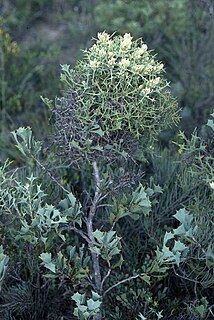
Hakea salicifolia commonly known as the willow-leaved hakea, is species of flowering plant that is endemic to eastern Australia. It is an adaptable, fast growing small tree or shrub with attractive foliage and cream white flowers.

Banksia stenoprion is a species of prostrate shrub that is endemic to the south-west of Western Australia. It has short, underground stems, pinnatisect leaves with triangular lobes, golden, mauve or purple flowers in heads of up to ninety, and egg-shaped follicles.

Hakea amplexicaulis, commonly known as prickly hakea, is a shrub endemic to south west Western Australia. An attractive small shrub with unusual stem clasping, sharply serrated foliage and a profusion of sweetly scented variable coloured flowers from late winter to spring.

Hakea trifurcata, commonly known as two-leaf, two-leaved hakea, or kerosene bush, is a shrub, endemic to the south-west of Western Australia. The species has two leaf forms, needle-like or oblong egg-shaped. Unlike most hakea species the fruit remain green at maturity and resemble the broader leaf form. The mimicry creates a camouflage, reducing predation of the seed by granivores in particular cockatoos.

Hakea cycloptera, commonly known as elm-seed hakea, is a shrub in the family Proteaceae endemic to South Australia. It is a small spreading shrub with an abundance of pale pink or white flowers from December to August.

Hakea chordophylla, commonly known as bootlace oak, bootlace tree, corkwood, or bull oak, is a species of shrub or small tree in the family Proteaceae found in central and northern Australia. Bares very showy golden yellow, pale green or cream nectar rich flowers in winter.

Hakea cristata, commonly known as the snail hakea, is a shrub in the family Proteaceae native to Western Australia. An ornamental prickly shrub with attractive foliage and creamy white rounded flowers appearing in profusion in the winter months.

Hakea trineura is a flowering plant in the family Proteaceae and is endemic to Queensland. The branches and leaves are covered with rusty hairs and the pendulous flowers are greenish-yellow.

Hakea cucullata, commonly known as hood-leaved hakea, cup hakea or scallop hakea, is a species of shrub in the family Proteaceae and is endemic to the south-west of Western Australia. An attractive shrub with unusual distinctive foliage and beautiful large pink, red or deep purple scented flowers.

Hakea auriculata is a reasonably common shrub in the family Proteaceae endemic to Western Australia. A very showy species in full bloom with creamy white, yellow, dark red or reddish purple fragrant flowers.

Hakea candolleana is a shrub in the family Proteaceae native to areas along the west coast in the Wheatbelt and Mid West regions of Western Australia. A cream-white winter flowering species, useful as a garden ground cover.

Hakea circumalata is a shrub in the family Proteaceae native to an area in the Wheatbelt and Mid West regions of Western Australia. A small shrub producing a profusion of strongly scented pink to red flowers in dense clusters from July to September.

Hakea cyclocarpa, commonly known as the ram's horn, wild bean or curved-fruit hakea is a shrub in the family Proteaceae. A strongly scented species with large creamy-white flowers with a red style and interesting fruit. Native to an area along the west coast and south west regions of Western Australia.

Hakea gilbertii is a shrub in the family Proteacea and is endemic to an area in the Wheatbelt region of Western Australia. It is an upright, prickly shrub with greyish needle-shaped leaves and clusters of fragrant flowers from late winter to spring.

Hakea kippistiana is a shrub in the family Proteacea and endemic to Western Australia. It is a dense prickly shrub with sharp needle-shaped leaves with fragrant white, cream or pink flowers from November to February.

Hakea meisneriana is a shrub in the family Proteaceae and is endemic to Western Australia. It has small, nectar rich, creamy white flowers in clusters in the upper branches from August to November.

Hakea pycnoneura is a shrub in the family Proteaceae. It has fragrant, pink-purplish flowers in the leaf axils. It is endemic to a small area on the west coast in the Mid West and a smaller area on the south coast in the Goldfields-Esperance regions of Western Australia.

Hakea stenophylla is a shrub or tree in the family Proteacea, with sweetly scented creamy-white flowers. It is endemic to Western Australia.

Hakea strumosa is a shrub in the family Proteacea endemic to an area in the Wheatbelt, Great Southern and the Goldfields-Esperance regions of Western Australia. A dense, very prickly shrub with a profusion of small, deep pink or red flowers in spring.

Hakea florulenta, commonly known as three-nerved willow hakea, is a woody shrub in the family Proteaceae and is endemic to eastern Australia.





















